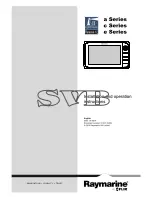
389D000 Rev B
14
3.
Place all items that may have come in contact with the agent(s), such as used pipettes, in a plastic bag
or other suitable container.
4.
Disinfect the entire inside surface of the cabinet.
For additional information on cleaning and disinfecting stainless steel, please refer to: “Decontamination,
Sterilization, Disinfection, and Antisepsis”, Vesley, Donald and Lauer, James L., Laboratory
Safety Principles
and Practices, Second Edition
, 1995, Fleming, D.O., Richardson, J.H., Tulis, J.J. and Vesley, D., editors, ASM
Press, Washington, D.C., pp. 219-237; and Biosafety Reference Manual, Second Edition, 1995, Heinsohn, P.A.,
Jacobs, R.R. and Concoby, B.A., editors, AIHA Publications, pp.101-110.
Cleaning the Drain Pan
CAUTION
It must be assumed that the Drain Pan is contaminated.
Spills that fall through the perforated grilles in the work surface should be mopped up and put in a disposal
container inside the work area to reduce the amount of liquid. The remainder can be removed through the drain
valve in the Drain Pan after proper decontamination of the work area. To clean the drain pan under the work
surface, lift the work surface, completely surface decontaminate the work surface and work surface supports,
then remove them from the work area. Removing these parts provides unobstructed access to the drain pan for
easy cleaning. The drain valve must be closed when cleaning of the drain pan is completed.
Decontamination
The cabinet must be decontaminated with an appropriate agent prior to maintenance, service or repairs in any
contaminated area of the cabinet. The National Institute of Health, National Cancer Institute and the Centers for
Disease Control have all recommended the use of formaldehyde gas for most microbiological agents. Only
individuals experienced in the decontamination of cabinets should use this substance since the gas itself is toxic.
A good reference for this procedure is the most current NSF/ANSI Standard 49-Annex G “Recommended
Microbiological decontamination Procedures”, NSF International, 789 North Dixboro Road, P.O. Box 130140,
Ann Arbor, Michigan, 48113-0140. NSF/ANSI 49 describes procedures for decontamination using either
depolymerized paraformaldehyde or chlorine dioxide. Decontamination using alternative methods, such as
vaporous hydrogen peroxide (VHP) should be thoroughly evaluated prior to use.
The gas to be used should be determined to be effective against all of the biological agents within the cabinet.
Personnel should always use the proper safety equipment (PPE) (gas masks, protective clothing, etc.) for the
specific gas. The antidote for the selected gas should be immediately available, in a visible and nearby location.
Carcinogens and other toxins present a unique chemical deactivation problem and standard biological
decontamination will not be effective against chemicals or other non-biological materials. A qualified safety
professional, knowledgeable of the hazard, should be consulted to determine the proper procedure in these
cases.
WARNING
Prior to usage of any decontamination agent, the user needs to check compliance with local, state and
federal environmental regulations



































